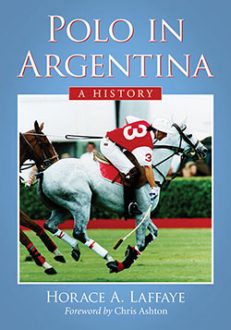Polo in Argentina
A History
$59.95
In stock
About the Book
This work—the first of its kind in more than sixty years—covers polo in Argentina, from its beginnings in the 1870s to the summer of 2013. The history of the early pioneers is constructed with data not previously published, gathered from contemporary sources. International competitions are covered and include the Olympic Games, the Cup of the Americas and the World Championships. Particular attention is given to the major clubs, the Argentine and Hurlingham Open Championships, and the National Handicap Tournament. Several of the elite players merit individual or family mini-biographies. Myths in Argentine polo are also debunked, based upon careful analysis of contemporary sources. Travels abroad by Argentine teams are fully described as are the foreign teams that competed in Argentina. The work is enhanced by the author’s personal observation of significant events and friendship with many of the participants.
About the Author(s)
Bibliographic Details
Horace A. Laffaye
Format: softcover (7 x 10)
Pages: 528
Bibliographic Info: 83 photos, appendices, notes, bibliography, index
Copyright Date: 2014
pISBN: 978-0-7864-7568-1
eISBN: 978-1-4766-1491-5
Imprint: McFarland
Table of Contents
Table of Contents
Acknowledgments ix
Foreword by Chris Ashton 1
Preface 4
1. How Polo Started in Argentina 9
2. The First Clubs and Polo in the Hinterland 16
3. The Game Is Organized: The Polo Association of the River Plate 28
4. The Oldest Clubs: Venado Tuerto, Hurlingham, Media Luna and Las Petacas 33
5. Early Championships 1893–1900 40
6. First International Game and Tours to England 50
7. Early Prominent Polo Families 57
8. Palermo: Polo’s Cathedral 66
9. The P.A.R.P. Championships Prior to the Great War 71
10. 1914, Changes to the Rules, and All That 80
11. 1922, a Time for Change: Polo Became Argentine 93
12. Polo in the 1920s 105
13. Campeonato Argentino Abierto de Polo 1923–1930 119
14. Gold Medals Only: The Olympic Games 128
15. Argentina versus U.S.A.: The Cup of the Americas 1928–1936 136
16. The Big Clubs: Growth and Evolution of Los Indios, Tortugas and Coronel Suárez 147
17. Visitors from Foreign Lands 152
18. Argentine Tours Overseas 165
19. Don Paco Ceballos and the National Handicap Championship 177
20. The Argentine Open Championship in the 1930s 185
21. The Years of the Great Depression 194
22. The War Years and the Aftermath 1940–1950 207
23. El Trébol and Venado Tuerto: The Glorious Days of the Giants 218
24. The Changing of the Guard 237
25. The Growth of the Game 1950–1960 251
26. The Cup of the Americas 1950–1980 259
27. The Aristocrat of Polo: The Times of Juancarlitos Harriott 272
28. The Days of Coronel Suárez versus Santa Ana 293
29. The Expansion of the Game in the 1970s 309
30. Argentine Military Polo 321
31. Travels Abroad and the Development of Professionalism 332
32. Argentina and the Federation of International Polo 344
33. The Era of La Espadaña 354
34. Myths in Argentine Polo 371
35. The Decade of Indios-Chapaleufú 375
36. 2005–2013: The Years of Ellerstina and La Dolfina 402
37. International Matches in the 21st Century and Some Final Thoughts 419
Appendix A. Polo Championships 429
Appendix B. Polo Pony Awards 460
Appendix C. Presidents of the Asociación Argentina de Polo 463
Appendix D. List of Polo Clubs in Argentina 464
Chapter Notes 478
Bibliography 486
Index 488
Book Reviews & Awards
“The book’s meticulously researched and deftly rendered history of the game in Argentina is further enhanced by the many photographs interspersed throughout its pages…will rank as a major contribution to the literature of the sport as well as the finest general history of polo in the pampas”—Polo Players Edition; “a well-written and detailed account…well illustrated with abundant photographic material…provides a much needed look at the famous clubs, essential associations, and historic polo figures that have contributed to Argentina’s important polo tradition…well-written, well-organized, and well-researched…important and fascinating material”—Journal of Sport History.





